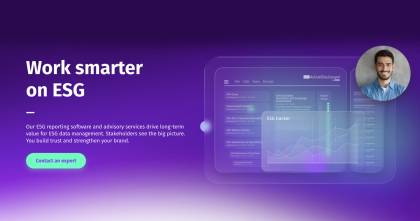Companies spend increasing amounts of time on commitments related to environmental, social and governance, or ESG, as it's known. ESG commitments are seen as good for people, good for the planet, good for business and a valuable way for a company to differentiate itself in the market. Companies that demonstrate their accomplishments, measure and manage risks, with broad governance programs, vis-a-vis ESG can use their efforts to appeal to customers, business partners, employees and other stakeholders.
An organization may be at one of many various stages of their sustainability journey, which directly impacts how to assign accountability for ESG data collection. For many organizations, ESG data management is not subject to executive management oversight because reporting remains within a business silo, such as human resources, investor relations, or corporate responsibility. Senior management of such organizations typically perceives ESG issues as non-material, and reporting is seen as a communication exercise. However, external stakeholders—including investors, customers, communities, and regulators— increasingly expect the board of directors to oversee the integration of ESG data management considerations into business strategy and monitor performance over time. Whether limited or reasonable, ESG assurance is now expected by a large segment of investors, regulators, and the general public, further underscoring the need for diligent data management.
What is ESG data?
Before we examine ESG data management principles, let's briefly outline what ESG data means. ESG is an acronym that stands for environmental, social and governance. ESG data thus refers to any data on these principles.
For example, categories of environmental data representing the E in ESG include:
Scope 1-3 GHG
Energy consumption
Water usage
Waste
Climate risk metrics such as TCFD/ISSB
In terms of S for social, some of the most relevant factors include:
Workforce safety
DEI (remove DEI put inclusion)
Pay equity
Supply chain labor
Privacy incidents
Finally, the G represents governance, which can be defined using data including:
Board composition
Independence
Anti-corruption efforts
Executive compensation
Internal controls
Cybersecurity
In many cases, these ESG metrics are mapped to regulatory frameworks such as ISSB, SASB, TCFD, or CSRD.
What is ESG Data Management?
Companies with leading sustainability practices have established board-level oversight of ESG risk and opportunities, well-defined governance structures, charters, policies, and processes designed to integrate ESG into strategy, risk management, performance measurement, and reporting. The board of directors and senior management sanction rigorous data management collection mechanisms and processes to ensure data quality (consistency, reliability, and traceability). Data owners are identified as responsible and accountable for completing data collection and reporting on specific ESG issues.
ESG data management is moving from a once-a-year communications exercise to quarterly and monthly reporting. This is beyond a simple spreadsheet approach. Companies need software that's capable of sophisticated ESG data analytics.
How to Collect ESG Data
Establish a team that consists of business and IT representatives and defines the purpose, goals, and milestones required in an ongoing ESG data management and reporting program. To implement a reliable ESG data collection process, consider the following:
- Collect clearly defined data requirements and data sources.
- Perform an assessment of what information and processes are in place. Identify and prioritize gaps in available data, mandatory data, and processes.
- Involve other departments already familiar with data collection and replicate relevant aspects of those processes.
- Maintain records and establish proper workflows and access control to preserve integrity.
- Align management and departments around understanding the need for ESG risk assessment and reporting.
- Establish a formal review process for data ownership and accuracy of reports.
Companies may hesitate to adopt a technology solution for ESG out of fear of change. Why invest in a data collection solution if ESG itself is in flux? However, this is a flawed belief.
ESG collection tools automate the process of aggregating data. Machine learning capabilities allow the tools to learn, and thus to create repeatable processes for data collection. There is too much data to manage without intelligent software solutions.
ESG data management software with features such as access control simplify the process of harvesting data. With access control, workflows can be assigned so that nothing gets lost or forgotten.
Integrations allow software to gather data from other applications. When relevant data points are imported via integrations, there is no chance of errors being introduced into the process.
Not only do companies need to collect ESG data; they must format it, report it and file it with regulatory agencies, including the SEC. Best-in-class solutions go beyond data collection to support the full lifecycle of ESG data management.
Emphasizing ESG Data Quality
Because ESG reporting remains voluntary and lacks the regulatory constraints that are intrinsic to financial reporting, the collection and preparation of ESG data remains an informal activity with little governance or formal processes. This lack of structure is often compounded by the fact that ESG data collection is siloed within business units or functions. In a highly matrixed organization, data may further be decentralized. In addition, oversight of ESG and sustainability reporting in some companies is considered more of a communication—not a financial or business exercise. ESG report data is typically collected by a communication or reporting team and the report is written by once-removed writers or third parties. This offers a deep-seated and subtle—but potentially harmful—reason for the preparation of reporting data being performed as an end-user activity with no formal processes: the effort is not considered to be strategic and material to business and value creation. Consequently, this undermines all aspects of data quality, such as reliability and traceability and makes it difficult for the data to be audited—internally or externally.
The single biggest impediment to having ESG data externally assured is the quality and reliability of the ESG data. However, even if an organization does not seek to obtain external assurance on its ESG information, improving the quality of data is critical for providing reliable data to internal and external decision-makers. Strong ESG data management practices are in place that include the collection, validation, storage, and movement of data. Data quality testing around reliability, completeness, and consistency makes it easily assurable or auditable. The same internal audit and disclosure controls that apply to financial reporting data should apply to ESG-related information.
Now that the quality of ESG data is clear, let's look at two variables that impact data collection and quality: data management solutions and ESG reporting partners.
What Does Best-in-Class ESG Data Management Look Like?
Companies that adopt ESG reporting technologies early and invest in best in breed partners enjoy advantages over those that delay. Best practices for ESG data management call for companies to inventory data, get organized and develop repeatable processes.
- Inventory data: Companies need to understand what kind of data they already gather, what relevant data is not yet gathered, what format the data takes and where it is currently stored. Think of this step as an internal audit or inventory. Once it's clear what data exists and what data is missing, companies can make a plan to capture all relevant high-quality data for ESG reporting purposes.
- Get organized: The data audit is the first step in organization. Next, companies must determine a plan for collecting and managing ESG data, including whose responsibility it is. As part of the organization process, consider what compliance measures are necessary. Is your data bound by HIPAA? GDPR? Similar standards? If yes, what regulations must you follow when working with data to stay in compliance?
- Develop repeatable processes: Without a process-based approach to guide their efforts, companies will almost certainly wind up with low-quality ESG data. To succeed with ESG data collection, companies must create workflows that can be run and repeated by those responsible. When companies are first building processes, they might not get it all right. That's to be expected. What matters is learning, tweaking the process and repeating the workflow so that what must be measured is measured.
- Select the right technologies: After these initial steps are complete, companies can look for technologies that support their ESG data collection. The right ESG data management solution will be easy to customize with adjustable processes, transparent, designed to stay ahead of ever-evolving regulations regarding ESG and capable of integrating with the company's technology stack.
Who is Collecting ESG Data?
Companies aren't the only ones collecting and using ESG data. Many have an ESG partner or partners. Not only do these interested parties need the data for their ends, but they also require that data meet particular standards. Companies need to understand who uses ESG data and how, so they can organize and format data for transmission via ESG reporting software.
Companies that collect ESG data include banks, investors, financial institutions, insurers, ESG rating organizations and regulatory agencies such as the SEC. Banks may use ESG data when determining whether to lend a company money. Insurers will review ESG data to determine whether to insure a company against certain risks. Rating organizations tally the company's performance towards its stated goals, as mentioned above. Financial institutions will report ESG data to investors, who may take this data into account when determining where to invest.
ESG Data Architecture and Controls
Generally speaking, a strong ESG data architecture is one based on the following four core pillars:
Governance and Ownership: This begins with a clear RACI model that defines who collects data, who validates it, and who approves it. Proper board and executive oversight ensures ESG is treated as strategic and material, and robust policies must align ESG reporting with financial reporting rigor.
Standardized Data Framework: Companies must have a metric dictionary with definitions, boundaries, units, and calculations. The central taxonomy must align to regulatory frameworks such as ISSB, TCFD, CSRD/ESRS, and GHG protocols. Methodologies should be consistent across global business units and suppliers. All this prevents changing calculations from undermining the trend analysis.
Controlled Data Pipeline: Systems should have automated ingestion via API/ETL from ERP, HRIS, EHS, utilities, facilities, and supplier systems. System-driven validation that includes completeness checks, variance checks, and audit logs also are necessary. Access controls and segregation of duties helps reduce manual errors and conflicts of interest.
Assurance and Reporting Readiness: This includes limited or reasonable assurance by third parties, as well as inline XBRL tagging for any regulatory submissions. The key elements here include end-to-end data lineage, documented internal controls and testing protocols, and long-term secure record retention and structured evidence repositories.
Benefits and Challenges
When done well, ESG data management allows companies to communicate key metrics about ESG importance, risk management, goals and performance. The key phrase here is 'when done well.' There are important benefits and challenges when it comes to working with ESG data that must be noted.
Benefits:
In brief, companies that collect high-quality ESG data enjoy benefits such as:
- Robust data to support decision making
- At-a-glance insight into what's working and what's not working (so it can be fixed)
- Key talking points to communicate progress on goals to stakeholders
- Perception of positive values, including transparency, accountability and trustworthiness
Challenges:
However, if companies are not collecting high-quality data, they are susceptible to challenges like:
- Operational inefficiency
- Negative reputation regarding trustworthiness, performance and reliability
- Accusations of greenwashing
- Difficulty convincing investors who rely on ESG data when making financing decisions
There is no one approach to working with ESG data. This is due in part to the huge variety within ESG data and differences such as formats, structure, source and applicable standards and regulations.
Rather than a checklist approach, seek to understand the process, rewards and challenges associated with ESG data management. Seek out partners who offer a blend of experience and flexibility. ESG data collection, data management and data analysis are complex and evolving issues. Ensure partners have the blend of knowledge and experience to stay up to date with relevant changes.
Learn more about how DFIN can help with your ESG reporting needs. Talk to a specialist today.

